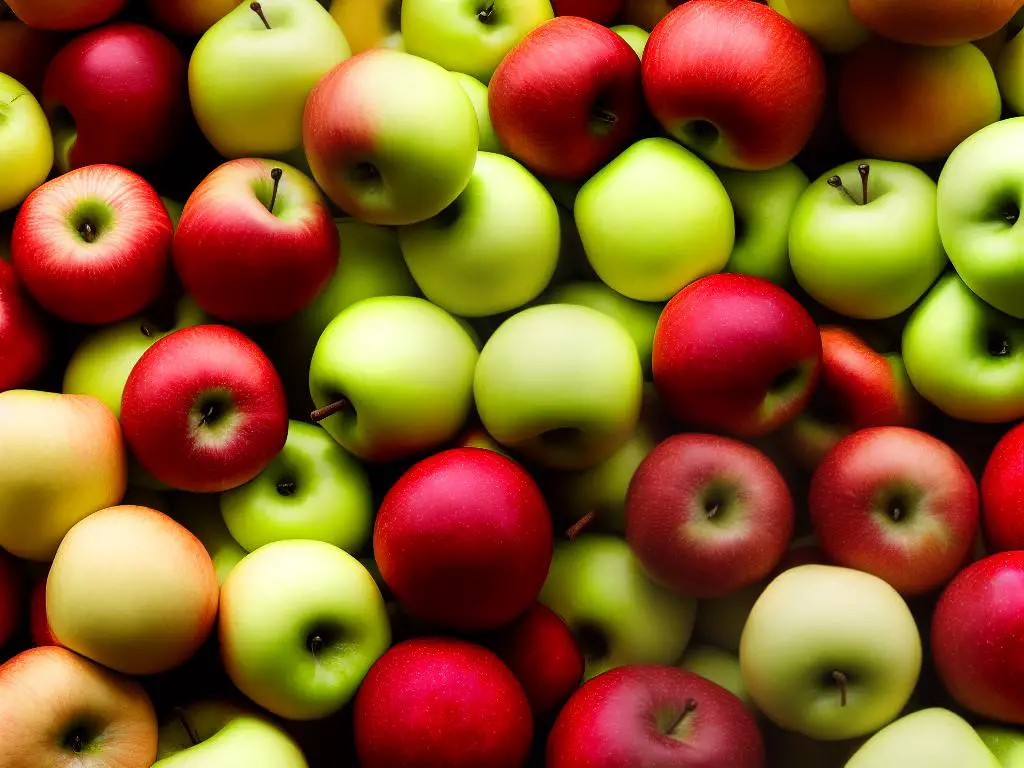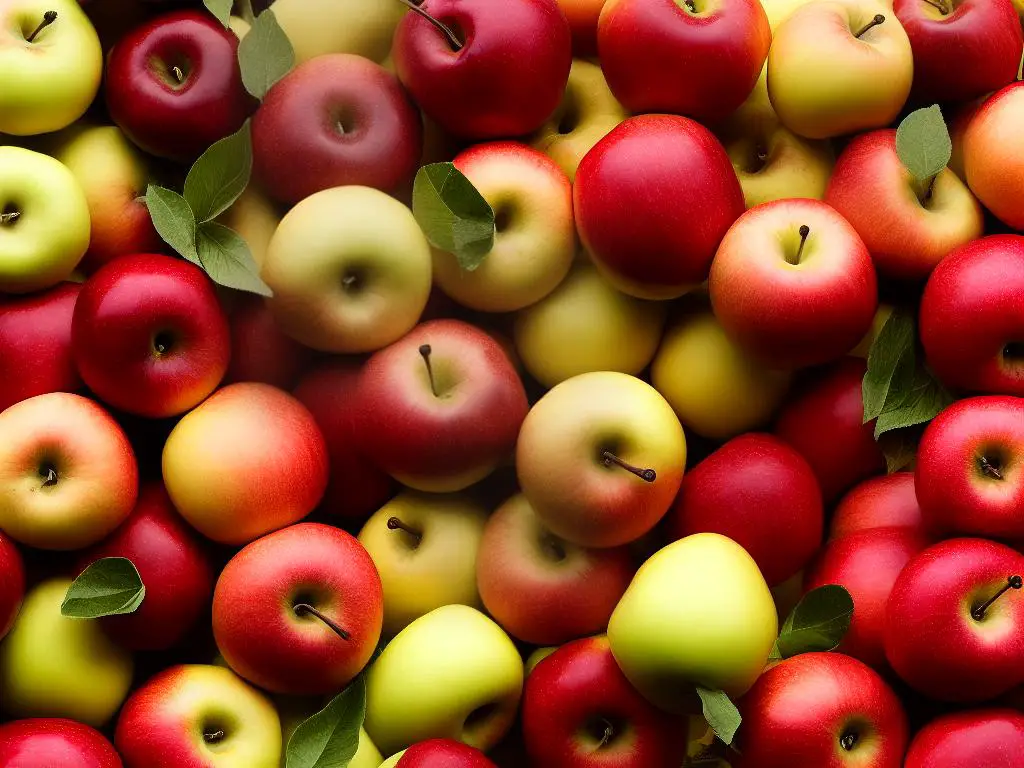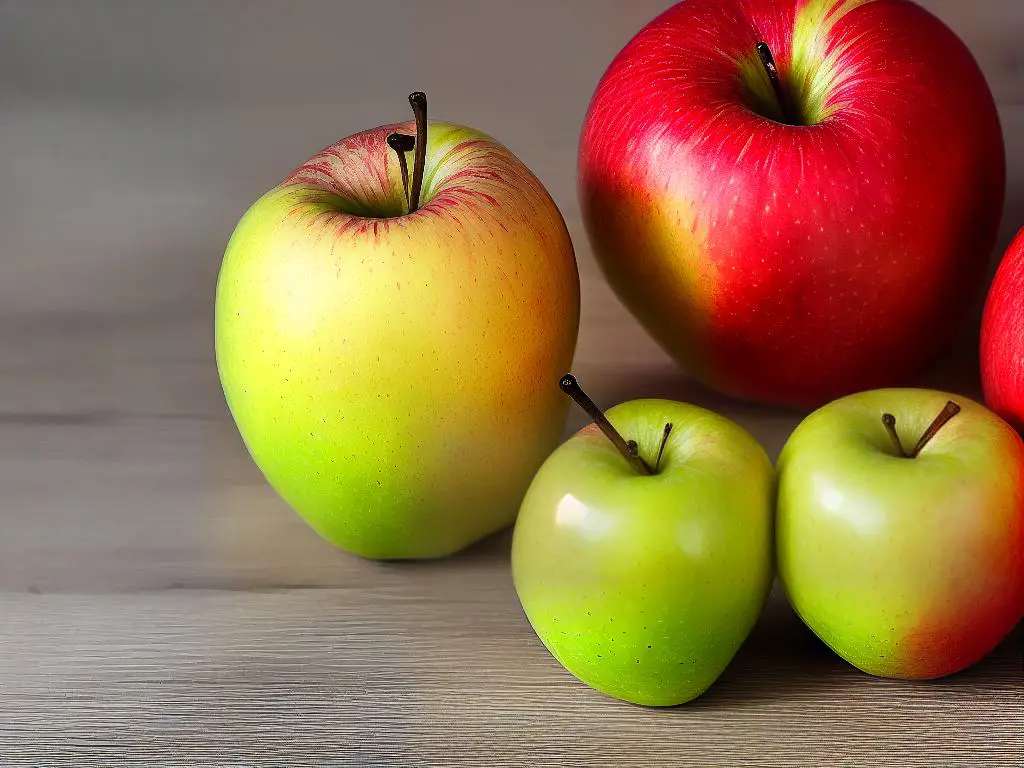Apples are ubiquitous in our daily lives, with their crisp flavors and vibrant colors. But have you ever paused to consider the weight of these quintessential fruits and how it may impact their taste and culinary uses? In this exploration, we delve into various aspects surrounding the average apple weight, examining different varieties, such as Fuji, Gala, Granny Smith, Golden Delicious, and Honeycrisp. Additionally, we analyze factors affecting apple weight, the relationship between size and weight, and even present practical tips on accurately measuring apple weight for a comprehensive understanding.
Average Apple Weight
The average weight of an apple can greatly vary depending on the specific variety, as some types of apples are larger and heavier than others. This difference in size and weight can make certain apples more suitable for specific uses, such as snacking, cooking, baking, or making cider.
For instance, the popular Japanese variety Fuji apple is known for its large size and sweet flavor. These apples typically weigh between 0.33 to 0.66 pounds (150 to 300 grams) each. Thanks to their hefty size and delightful sweetness, Fuji apples are a go-to choice for enjoying as a snack or using in dessert recipes like pies and crisps.
On the other hand, the New Zealand-origin Gala apple is smaller and lighter compared to the Fuji apple, with weights typically ranging from 0.25 to 0.44 pounds (113 to 200 grams). These apples are beloved for their mild, sweet, and slightly tart flavor, which makes them versatile enough to be enjoyed fresh or used in both cooking and baking recipes. Due to their handy size, they are also perfect for packing in lunches and serving as a snack.
An apple enthusiast would be familiar with the easily recognizable Granny Smith apples, thanks to their unique green color and tart flavor. Generally weighing around 0.3 to 0.44 pounds (136 to 200 grams) each, these Australian apples are similar in size to Gala apples. They are commonly utilized in baking and cooking for their tartness that adds deep flavors to various dishes, and they are also eaten fresh, particularly by those who prefer a tangy taste.
True to their name, Golden Delicious apples have a golden-yellow color and possess a sweet, mild flavor. Native to West Virginia, these apples usually weigh from 0.31 to 0.44 pounds (140 to 200 grams) each. The versatility of Golden Delicious apples allows them to be enjoyed fresh, used in salads, or incorporated in dessert recipes. Moreover, their sweetness makes them a popular choice for creating applesauce and cider.
Hailing from Minnesota, Honeycrisp apples are a fairly recent variety that have become increasingly popular due to their unique sweet-tart taste and satisfying crunch. These larger apples typically have average weights between 0.33 to 0.66 pounds (150 to 300 grams). Like the previously mentioned varieties, Honeycrisp apples can be enjoyed fresh, used in baking, or added to salads, providing a delightful burst of flavor and texture. Their distinct size and taste have attracted many apple enthusiasts.

Factors Affecting Apple Weight
Several factors can influence the weight of an apple, one of which is genetics. Apple cultivars or strains, specifically bred for specific traits, can significantly impact the size and weight of the fruit. For example, some types of apples, such as the Asian variety, ‘Shinano Sweet’, can weigh up to 500 grams or more, while smaller types, like the crabapple, rarely exceed 50 grams. The genetic potential for fruit size is primarily determined by the plant’s DNA, allowing growers to select strains that produce the desired weight and size.
In summary, the weight of an apple can vary greatly depending on its type and genetics, and each variety has its own unique characteristics that make it particularly suitable for specific uses or preferences. As you explore the diverse apple types available, consider how their size, weight, and flavor will best suit your needs and taste buds.
In addition to genetics, cultivation techniques also play a role in determining the weight of an apple. The care and maintenance provided to an apple tree during its growth can directly affect how much the fruit weights. Factors such as planting density, pruning, and fertilization can all impact the size and weight of apples. For instance, growers can manipulate the number of apples per tree by thinning out the fruit early in the season, allowing the remaining apples to have access to more of the tree’s resources, and therefore potentially increasing their size and weight.
Environmental conditions also play an essential role in affecting the weight of apples. Factors such as sunlight, water availability, and temperature can all impact an apple’s growth and development. Adequate sunlight is necessary for the process of photosynthesis, which provides energy for the fruit’s growth. Similarly, water availability is crucial for optimal tree health and fruit production. A drought during the growing season could limit the fruit’s growth and decrease its weight. Temperature is another crucial factor, as extreme heat or cold can impact fruit development and influence its final weight.
Pest and disease pressure is another factor that can impact the weight of an apple. A variety of pests and pathogens can damage apple trees and fruit, with consequences that range from cosmetic blemishes to severe developmental issues. In particular, the health and vigor of apple trees during bloom are crucial for maximizing fruit set, which can ultimately dictate the number of apples a tree produces, and potentially affect the average weight of each individual piece of fruit.
The timing of harvest plays a significant role in determining the weight of an apple. Apples picked too early may not have reached their full growth potential, resulting in smaller and lighter fruits. On the other hand, apples left on the tree beyond their ideal harvest window may become heavier as they continue to absorb water and nutrients, but their overall quality and flavor might decline. Thus, harvesting at the proper time is crucial for balancing both weight and quality considerations.

Apple Size vs. Weight
Considering that apple size and weight vary considerably based on the variety and growing conditions, they can generally range from the size of a cherry to that of a grapefruit. The weight of an apple usually corresponds to its size, meaning larger apples weigh more than smaller ones. However, factors such as density and water content can also influence the overall weight of an apple, making it essential to consider these aspects alongside size.
There are around 7,500 different varieties of apples, and each variety has its own unique characteristics when it comes to size, weight, and density. For example, a small Granny Smith apple may weigh around 5-6 ounces (140-170 grams), while a larger Honeycrisp apple may weigh around 10-12 ounces (280-340 grams). Factors such as soil composition, climate, and proper care during the growing phase can greatly influence the size and weight of the fruit produced.
Although size is a significant factor in determining the weight of an apple, density plays a crucial role as well. Density refers to the mass per unit volume, or how much matter is packed into a certain space. For apples, this can relate to the thickness of the apple’s skin, the firmness of its flesh, and its overall composition. A denser apple will generally weigh more than a less dense apple of the same size, as it contains more mass within the same volume.
It is also important to note that there are exceptions and irregularities when it comes to apple size and weight. Apples do not always follow a standard pattern of increasing weight with increasing size. In some cases, two apples of similar size may have a considerable difference in weight due to variances in density and water content. Water content plays a key role in determining the weight of an apple, as a higher water content will lead to a heavier fruit. The water content can be influenced by factors such as climate, ripeness, and storage conditions.
It is essential to understand that apples, like all fruits, come in various sizes and weights due to multiple factors involved in their growth. Factors such as weather, soil conditions, and exposure to sunlight during the growing process may cause weight variations even within the same apple variety. Moreover, selective breeding for specific traits leads to the development of new cultivars with distinct characteristics like larger size or higher density. Keeping these variables in mind is crucial when comparing and estimating the weight of apples.

How Apple Weight Influences Flavor and Uses
The weight of apples not only varies among different varieties but also influences their flavor and texture. Generally, an apple’s weight can range from 70 to 200 grams, depending on its size and type. It is observed that smaller apples tend to have a more concentrated flavor, while larger apples might possess a more diluted taste. The weight of an apple significantly impacts its culinary uses as well, determining the desired outcome of a recipe or dish based on the specific requirements.
The skin-to-flesh ratio is another aspect that might be affected by the weight of an apple. Smaller apples usually have a higher skin-to-flesh ratio, resulting in a more robust and concentrated flavor. This might be particularly desirable in recipes that call for a strong apple taste, such as apple pies or ciders. Furthermore, apples with a thicker skin might weigh more, and the skin can add an interesting textural element to certain recipes while providing additional nutrients and fiber.
On the other hand, larger and heavier apples tend to have a more subtle flavor and provide a higher volume of flesh. These apples might be ideal for dishes that require more apple volume while not overpowering the other ingredients. Examples of such dishes might include salads, sauces, or stuffing mixtures. Larger apples can be particularly useful in recipes that involve baking or roasting, as they provide a moist, tender flesh that pairs well with savory and sweet flavors alike.
Additionally, the weight of an apple can influence the cooking process. Smaller, lighter apples might cook more quickly and require less preparation time, which can be advantageous in fast-paced kitchen environments. Conversely, larger, heavier apples might require longer cook times and more attention to ensure even cooking throughout. The weight of the apple can also determine the yield of a given recipe, as heavier apples typically produce a greater quantity of juice, sauce, or filling.
Understanding the weight of an apple is essential, as it can influence the fruit’s texture when consumed raw or in dishes with minimal cooking requirements. Smaller, lighter apples often provide a crispy, firm texture that’s great for snacking, while larger, heavier apples can have a softer, more tender texture suitable for culinary uses like smooth applesauce or purees. Ultimately, knowing the apple’s weight will help one determine the best apple variety for a specific recipe or method, as well as personal preferences regarding taste, texture, and eating experience.

Measuring Apple Weight Accurately
To accurately measure an apple’s weight, one can use a digital scale specifically designed for weighing small items or food. These scales usually offer various units of measurement, such as ounces, grams, or pounds, allowing users to choose based on their preference. It’s essential to select a digital scale with a high precision level—typically to the nearest 0.1 grams—to guarantee the most accurate apple weight measurements. Place the apple on the scale’s platform and wait for the digital indicator to stabilize before noting the exact weight of the apple. Having this information will allow you to plan recipes, portion sizes, or nutritional intake more effectively.
Many apples sold in grocery stores have a standardized weight range due to the grading and sizing protocols in place for apple growers and distributors. Typically, apples are categorized by their diameter, which in turn influences their weight. For instance, extra-small apples usually range between 4 and 5 ounces in weight, while large apples can weigh between 8 and 9 ounces. However, keep in mind that the actual weight of an individual apple may differ slightly from these standardized ranges due to factors like moisture content, density, and other natural variations in size and shape.
Understanding the units of measurement while measuring apple weight is essential in accurately gauging how much an apple weighs. The two most common units are grams (g) and ounces (oz). One ounce is equivalent to about 28.35 grams. Knowing the conversion factor between these two units will allow for an easy conversion from one unit to another. For example, if an apple weighs 6 ounces on a digital scale and one wishes to know its weight in grams, simply multiply 6 ounces by 28.35 grams to get the weight in grams (6 oz x 28.35 g/oz ≈ 170.1 g).
In addition to using digital scales and understanding units of measurement, it is crucial to account for potential inaccuracies in your apple weight measurements. Some factors that can influence the accuracy of an apple’s weight measurement include the apple being slightly under or overripe, the presence of bruises or blemishes on the apple, and variations in apple density. To ensure the most accurate measurements, make sure your digital scale is calibrated correctly and follow the manufacturer’s guidelines for use and maintenance.
There are also alternative methods for estimating apple weight without the use of digital scales. One of these methods involves comparing the size of the apple to standard household objects. For instance, a medium-sized apple (weighing approximately 6 ounces) is approximately the same size as a regulation baseball. However, this method should only be used as a rough estimation, as it does not account for variations in apple density and shape. In conclusion, understanding the relationship between diameter, weight, and units of measurement, and using a precise digital scale, will provide the most accurate results for measuring apple weight.

Through this investigation, we gained insights into the fascinating world of apples and discovered how factors such as genetics, cultivation, and environmental conditions can significantly influence their weight. Moreover, we learned about the numerous apple varieties, their respective average weights, and the impact weight has on flavor, texture, and various culinary applications. By better understanding the intricacies of apple weight and measurements, we can broaden our horizons, appreciate these fruit’s complexities, and make informed choices when cooking, baking, or simply enjoying an apple as a satisfying snack.
